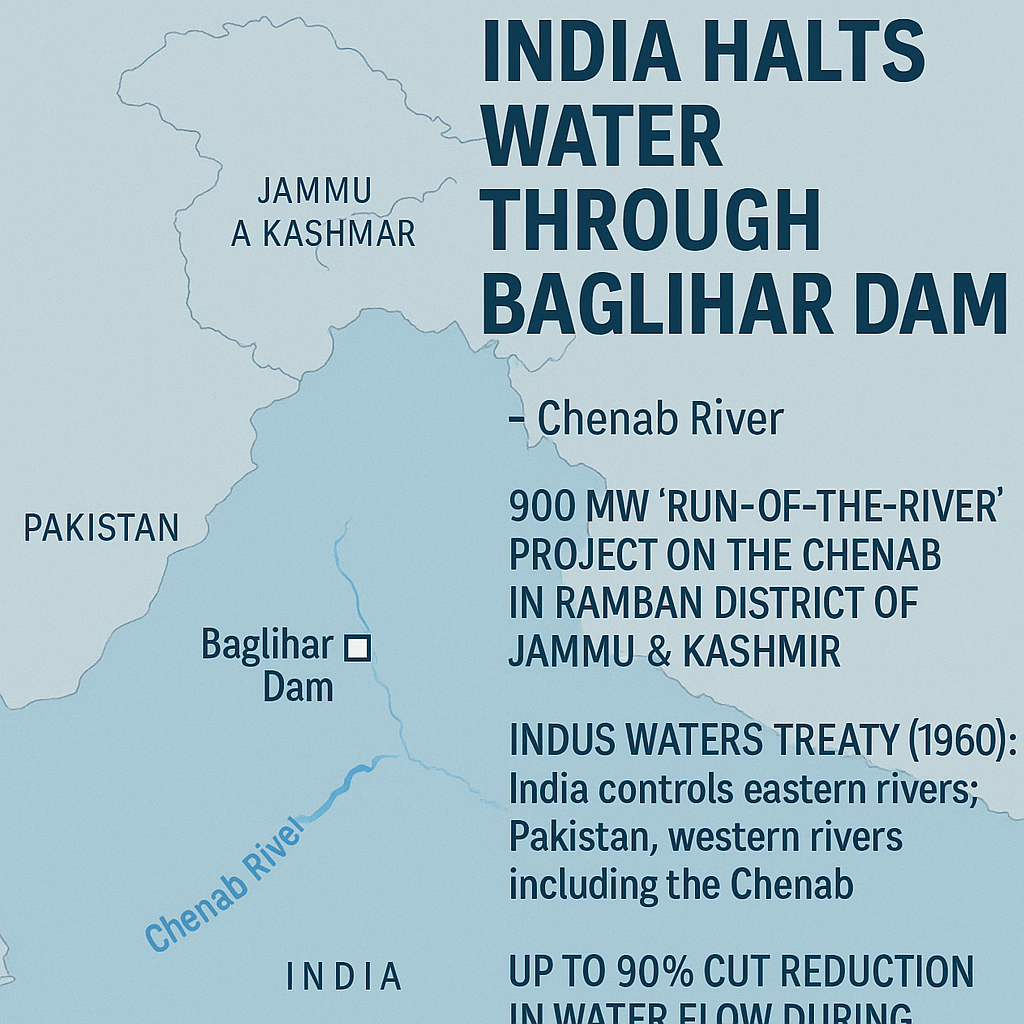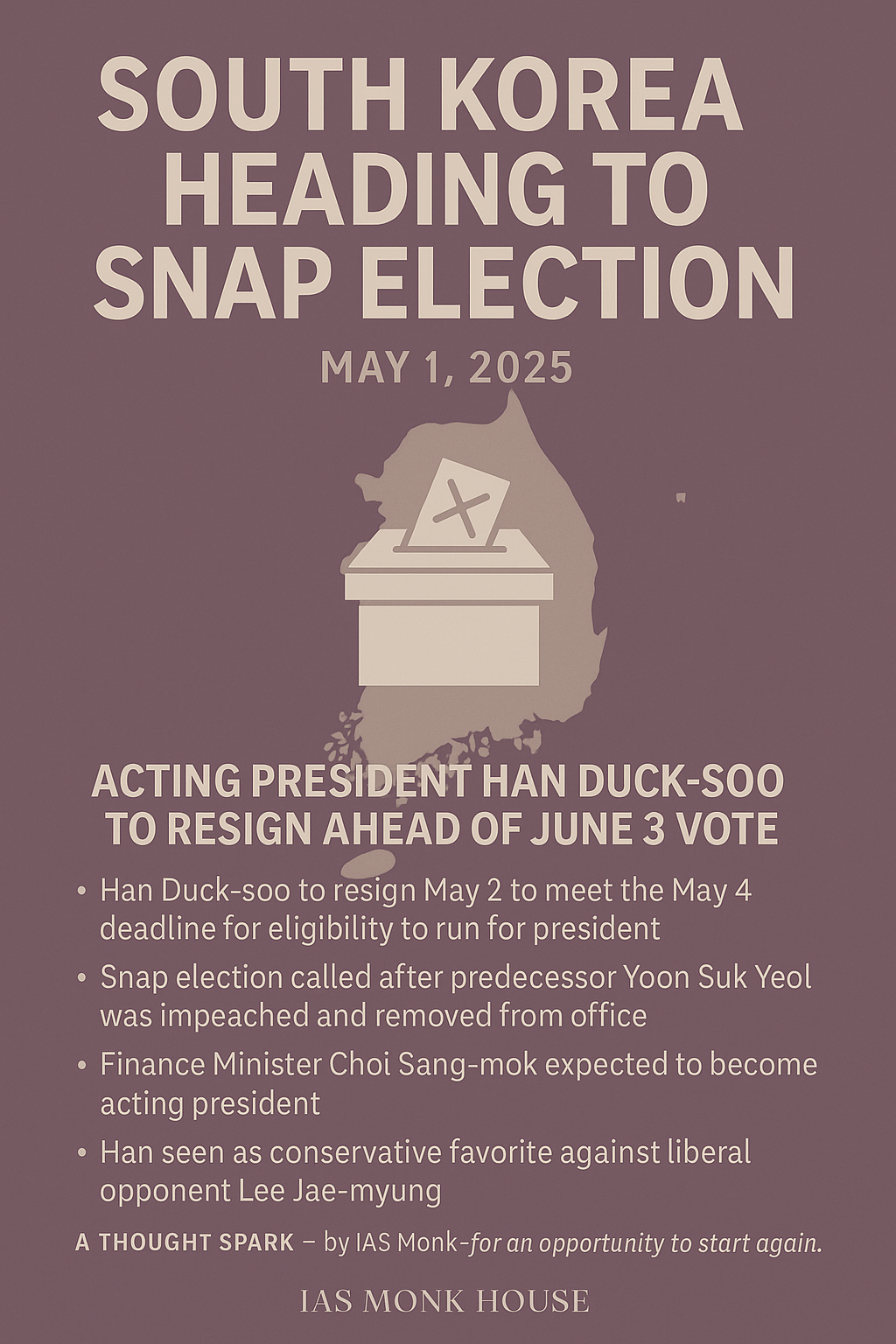
📅 May 6, 2025, Post 17: India Cuts Chenab Flow: Baglihar Dam and the Ripple in Indo-Pak Water Diplomacy | Target IAS-26 MCQs Attached: A complete Package, Dear Aspirants!
India Cuts Chenab Flow: Baglihar Dam and the Ripple in Indo-Pak Water Diplomacy

🔹 NEWS DROP — PETAL 017
📅 May 6, 2025
🎯 GS Paper 2 & 3 | International Relations, Water Security, Infrastructure
🌀 Intro Whisper
When rivers are restrained by walls and warnings, diplomacy must flow stronger than water — or flood into conflict.
🔍 Key Highlights
- India has restricted water flow from the Baglihar Dam on the Chenab River, citing de-silting and maintenance operations.
- This move follows heightened tensions after a terror attack in Jammu & Kashmir, signaling a strategic shift in water diplomacy.
- Baglihar Dam:
- Run-of-the-river project (900 MW), operational since 2008, located in Ramban district, J&K.
- Kishanganga Dam:
- 330 MW project on a tributary of the Jhelum in Gurez Valley, also under scrutiny by Pakistan.
- Reports indicate up to 90% reduction in downstream Chenab flow during the operation.
- India is advancing 4 key hydropower projects in J&K: Pakal Dul, Kiru, Kwar, and Ratle, expected by 2027–28.
- Indus Waters Treaty (1960):
- Mediated by the World Bank, it gives India control over eastern rivers and Pakistan over western rivers (Chenab, Jhelum, Indus).
- Pakistan sees the water halt as a treaty violation, further escalating diplomatic tensions.
🧭 GS Paper Mapping
GS2: Governance – Intergovernmental Agreements and Treaty Obligations
GS2: International Relations – India-Pakistan Treaties
GS3: Water Resources – Hydropower, Irrigation Diplomacy
Target IAS-26: Daily MCQs :
📌 Prelims Practice MCQs
Topic:
🧠 Prelims MCQ (Type 3 – Multiple Correct Options)
Q. With reference to the Indus Waters Treaty and related hydropower projects, consider the following statements:
1. India has exclusive rights over the waters of the Indus River under the treaty.
2. Baglihar and Kishanganga dams are located on rivers allocated to Pakistan under the treaty.
3. The treaty allows India to construct run-of-the-river projects with limited storage capacity.
4. The World Bank played a key role in mediating the treaty signed in 1960.
How many of the above statements are correct?
A) Only two
B) Only three
C) All four
D) Only one
🌀 Didn’t get it? Click here (▸) for the Correct Answer & Explanation
✅ Correct Answer: B) Only three
🧠 Explanation:
•1) ❌ Incorrect – India has rights over the eastern rivers (Ravi, Beas, Sutlej), not the Indus.
•2) ✅ Correct – Both Chenab and Jhelum (where these dams are located) are western rivers, allocated to Pakistan.
•3) ✅ Correct – The treaty permits run-of-the-river projects with specified design constraints.
•4) ✅ Correct – The World Bank was the mediator in the treaty negotiations.
MCQ 2 – Type 2: Two Statements Based
Q. Consider the following statements about India’s solar energy progress:
• 1) India added over 24 GW of solar capacity in 2024, the highest ever in a single year.
• 2) India’s solar capacity reached 100.33 GW as of January 2025, up from 2.82 GW in 2014.
Which of the above statements is/are correct?
A) Only 1 is correct
B) Only 2 is correct
C) Both are correct
D) Neither is correct
🌀 Didn’t get it? Click here (▸) for the Correct Answer & Explanation
✅ Correct Answer: C) Both are correct
🧠 Explanation:
• 1) ✅ Correct – 24.5 GW of solar capacity was added in 2024.
MCQ 3 – Type 3: Which of the statements is/are correct?
Q. Which of the following statements is/are correct about the policy and scaling needs of Agriphotovoltaics (APVs) in India?
• 1) India currently has a dedicated nationwide agrivoltaics policy.
• 2) PM-KUSUM scheme can be expanded to include APV models.
• 3) Smallholder farmers can benefit from financial incentives and credit guarantees for APV adoption.
• 4) Technical training and capacity-building programs are essential for APV expansion.
Options:
A) 2, 3, and 4 only
B) 1 and 2 only
C) All four
D) 1 and 3 only
🌀 Didn’t get it? Click here (▸) for the Correct Answer & Explanation
✅ Correct Answer: A) 2, 3, and 4 only
🧠 Explanation:
• 1) ❌ Incorrect – India currently lacks a designated agrivoltaics policy.
MCQ 4 – Type 4: Direct Fact
Q. Who first proposed the concept of Agriphotovoltaics (APVs)?
A) Sunder Lal Bahuguna and Vandana Shiva
B) Adolf Goetzberger and Armin Zastrow
C) Verghese Kurien and M.S. Swaminathan
D) Elon Musk and Andrew Blakers
🌀 Didn’t get it? Click here (▸) for the Correct Answer & Explanation.
✅ Correct Answer: B) Adolf Goetzberger and Armin Zastrow
🧠 Explanation:
• • The idea of agrivoltaics was first proposed in 1981 by German scientists Adolf Goetzberger and Armin Zastrow.


















